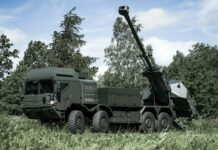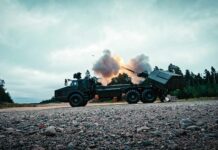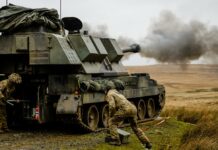The British Army has suffered from significant capability decline in a number of critical areas in recent years, including armoured vehicles and artillery. This is not to suggest that deficiencies in these critical areas have remained unknown or deliberately ignored. On the contrary, there have been numerous statements by government and military figures that steps were being taken to correct these problems and that solutions would soon be fielded. Yet time has passed, and for all the statements made and the good intentions expressed, very little has changed.
Before venturing further, it might be useful to pose the question: after the end of the Cold War, what was the primary mission of the British Army? If it were to confront a peer or near-peer competitor, then it would need the appropriate conventional weapons for high intensity mechanised conflicts. In these circumstances, effective armour and artillery capabilities were essential and that is where you would invest your procurement funding. The important point to note is that for much of the post-1990s, there was never any intention of confronting a peer/near-peer competitor in a conventional conflict.

Security threats were plentiful, as it was an era of asymmetric conflicts in multiple locations around the globe. Consequently, the military assets required would have to be lighter, more mobile and easily deployable. Anti-air threats were minimal. As such, it was thought that this was not the environment for a heavy armoured force supported with numerous artillery assets. If these systems were not really required, then they would be low down the priority list for funding for replacement or upgrade programmes.
The other problem confronting the British Army was the dysfunctional British procurement system, a system in which efficient programme management and sound financial management appeared to be very difficult to achieve. The other two services, the Royal Navy (RN) and the Royal Air Force (RAF), seemed to be far more effective in turning their equipment requirements into functioning procurement programmes than the Army could manage. Might the success of the RN and the RAF in playing the procurement system also be a function of the British Army being unable to articulate what its role was within an uncertain international political and strategic environment?
Responding Slowly
With the War in Ukraine this security environment represents a conventional and clearly understandable threat that would obviously see NATO ground forces respond by upgrading their conventional combat capabilities. Unfortunately, although the threat might have been clear, the reaction was somewhat anaemic. Rebuilding conventional capabilities was going to take time, despite the fact that the British Army was starting to make progress on confronting its conventional credibility gaps. There were real procurement programmes in progress in terms of armoured vehicles and plenty of ideas on how to regenerate artillery capabilities.
As far as artillery capabilities were concerned, there were a number of programmes grouped under the overall rubric of Long-Range Fires. These were classified as Close Support and Deep Fires efforts, with the first programme to become a reality based on M270 Multiple Launch Rocket System recapitalisation and range extension for Land Deep Fires. MLRS will be upgraded to the M270B1 configuration and utilise the Guided MLRS Extended Range (GMLRS-ER) rocket which would boost engagement ranges from 84 km out to 150 km.
Other artillery programmes are the Dismounted Joint Fires Integrator (D-JFI) and fire control systems, that will “deliver enhancements in the integration of Joint Fires producing target effect in the land environment.” This programme is currently in the assessment phase. Then comes the Close Support Fires Programme (CSFP), which included the Mobile Fires Platform (MFP) and the Tactical Guided Munitions Indirect (TGMI) programmes. The latter vision was officially described as such: “Guided munitions with increased range and accuracy that can be fired by current and future Close Support Fires platforms.” The programme is in the concept phase, transitioning to being funded. Mention should also be made of an outline programme to replace the L118 105 mm Light Gun. Currently 129 guns are in service, with the out-of-service Date (OSD) being 2030; the successor requirement is known as the Lightweight Fires Programme (LFP).
MFP, the second component of CSFP, is described as “a Close Support Fires platform to replace AS90.” MFP has reached the concept stage, but the poor state of the British Army’s 155 mm artillery capability has seen this programme gain significant momentum and it is on the verge of becoming a fully live competitive procurement effort.
Declining Capability
AS90 was designed in the 1980s as a replacement for the British Army M109 fleet in the 1990s, hence the name ‘Artillery System for the 1990s’ or AS90. In total, 179 of these 155 mm L39 self-propelled howitzers (SPHs) were acquired, though the downside was that they arrived in the 1990s once the Cold War was over, at the point when the British Army was really getting out of the business of operating large numbers of SPHs. With the long-awaited conflict on the North German Plain disappearing from the British threat calculus, the British Army shrinking and the continental commitment evaporating, active AS90 numbers declined rapidly. According to official Ministry of Defence (MoD) figures, by 2016 the number of active AS90 systems had declined to 89.

Even though AS90 numbers were massively reduced and the sort of conventional capability they represented had lost emphasis, there were still efforts to further develop AS90. Artillery developments elsewhere and an understandable desire to enhance the AS90 led to a number of upgrade proposals; the most obvious proposed change was the replacement of the L39 gun with a longer L52 gun to greatly increase engagement ranges. As time went on, there were also proposals to replace systems within the AS90 that were becoming difficult to support, or needed to be replaced as part of an improvement effort. An AS90 upgrade was certainly viable and would have resulted in real capability growth, though sadly the money was never found for progressing an upgrade effort.
Eventually though, as AS90 numbers continued to decline, the first steps were taken to resurrect the 155 mm artillery capability, and this was the genesis of MFP. Fundamental to the selection of any NATO 155 mm artillery system is that it complies with the Joint Ballistic Memorandum of Understanding (JBMoU), whereby NATO nations adopted standards for 155 mm artillery systems and ammunition to ensure that they are interchangeable between the signatory nations. However, in the context of MFP, the required range of 80 km was, at least at that time, not likely when compliant with the 23 litre chamber volume specified in the JBMoU.
At this point, MFP seemed to be reflecting the direction that Germany was heading in as regards artillery. They also wanted extended range, and this saw interest in a Rheinmetall proposal of 155 mm L60 gun. There was also a suggestion of an artillery system with a much larger, and therefore non-JBMoU compliant, chamber volume. Many recent artillery developments from Rheinmetall in terms of gun technology, ammunition and charges could yet play a significant role in the MFP programme, especially since extended ranges are being reached with JBMoU-compliant artillery.
According to Rheinmetall, their current 155 mm Base Bleed (BB) round reaches 40 km with current modular charges, out of a 52 calibre barrel, with the Extended Range Charge (ERC) that they intend to introduce, range increases out to 46 km and will reach 52 km in the medium term. They also have a Velocity enhanced – Long-range Artillery Projectile (V-LAP) round that currently reaches a range of 54 km, increasing to 63 km with the ERC; the objective is to reach 68 km in the medium term.
The ideas floated at the start of the MFP process in terms of range, rate of fire and system weight all turned out to be too ambitious at that time, hence the programme pivoted towards something more achievable. There was also the suggestion that an 80 km range for MFP was unnecessary, as extended ranges out to 80 km and beyond would be covered by GMLRS and there was therefore no need to duplicate capability. On the other hand, with the envisaged service life of MFP being 30 years, the system must be capable of ‘Forward Capability Insertion’ to upgrade capability throughout its service life. Such upgrades could include new ammunition, enhanced automatic loading, improved ordnance, automotive upgrades such as hybrid propulsion and autonomous operation.
A re-focused MFP effort was then based upon a 155 mm L52 gun on either a wheeled or tracked platform, with the acquisition of a new range of ammunition options under the TGMI programme and an advanced modular charge system. The idea was that the AS90 would have an out-of-service date of 2030 and that MFP would be available at some point ‘later this decade.’
New Factors
That the AS90 was being discussed as having a 2030 out-of-service date seemed delusionally optimistic – while the officially stated AS90 fleet size was 89 systems (as of September 2022), the reality was that at best less than 30% of this fleet was actually usable. As for the rest, it was in store, some systems were salvageable, many more were only fit for cannibalisation. Effectively the British Army was on the road to having zero 155 mm artillery capability, and most likely this would come long before 2030.
Russia’s invasion of Ukraine in February 2022 made it impossible to ignore the poor state of 155 mm artillery in Britain. The course of military operations in Ukraine provided conclusive proof of the importance of tube artillery and, as a result, there started to be more emphasis on improving Britain’s capability. However, other factors would complicate the British artillery picture.
Britain has made major efforts to supply Ukraine with weapons and ammunition. In response to Ukrainian requests for more artillery, in January 2023 the British Government agreed to supply 20 operationally capable AS90, plus 12 more that could be refurbished or broken up for spares. The first AS90s entered combat in Ukraine in late June the same year. Given that it had donated the majority of its usable systems, this effectively left the British Army without a credible 155 mm artillery capability.

As a result, Britain embarked on a programme to acquire an interim artillery capability that would fill the gap until the MFP eventually comes online. In January 2023, they commenced talks with Sweden on the acquisition of 14 BAE Systems Archer 155 mm L52 mm truck-mounted artillery systems and on 16 March, Defence Equipment & Support (DE&S) announced that 14 artillery systems would be transferred to Britain later that month and the systems would become operational with the British Army in April 2024. In a related development, DE&S announced a major 155 mm ammunition contract with BAE Systems in July 2023, which they said: “will increase the UK’s stockpile and deliver an eight-fold increase in production capacity.”
Sweden had originally ordered 48 Archer systems and the 14 systems for Britain will be drawn from this source. Additionally, eight systems from Sweden’s fleet were supplied to Ukraine. In June 2022, it was announced that Sweden would purchase an additional 24 systems.
In August 2022, armasuisse, the Swiss Federal procurement authority, announced that it had established a shortlist for the replacement of their existing M109 KAWEST artillery systems, which are to be withdrawn from service by 2030. They will compete the Archer against the KNDS RCH 155 (Remote Controlled Howitzer 155 mm), with the latter system to be evaluated mounted on both the Boxer and the Piranha 8×8 platforms. Ukraine is on course to receive 18 RCH 155 systems.

It is significant that the UK MoD chose to talk to BAE Systems in order to acquire an interim artillery solution, especially since relations between the British Army and the company have been troubled. Equally significant is that the MoD apparently chose not to talk to Hanwha in any depth about the interim requirement, especially since the Korean company had demonstrated its ability to rapidly supply artillery systems. In July 2022, Poland announced that they would purchase 48 K9PL artillery systems, with contracts already signed in August 2022, and the first 24 guns ready for delivery in October and arriving in Poland on 5 December that same year.
The Archer will fill Britain’s 155 mm artillery gap from 2024, yet even so, it is problematic that the British Army will only have 14 modern SPHs in this category until MFP arrives. This had led to speculation that more Archer systems might be purchased, and there is clearly a need for more guns. However, thus far there has been a clear effort to treat the Archer as an interim purchase and MFP as the future artillery solution that has yet to be competed.
Stiff Competition
Assuming that MFP becomes an active acquisition programme, there are obvious contenders that will have to be evaluated. BAE Systems’ Archer, Hanwha and Team Thunder with the K9A2, Elbit and Rheinmetall’s yet-to-be-named ‘Automated 155 mm L52 wheeled self-propelled howitzer’, KNDS with either the RCH 155 on Boxer or the CAESAR system. Other 155 mm L52 proposals might yet emerge, but it is obvious that there are a substantial number of serious competitors that will have to be evaluated.

System performance will not be the only metric for evaluation, since inevitably price will be an issue as will British industrial involvement for production and sustainment. Another important factor is ‘Social Value,’ as this has been a major factor in how policies, programmes and projects are evaluated since January 2021. Social Value aims to “make the delivery of wider economic, environmental and social goals an integral part of the procurement process,” according to Lexington, a major corporate consultancy.
The UK Government wants procurement programmes to strengthen the defence industry by creating new skills and capabilities, along with supply chain resilience. Other factors that could come into play might include “tackling economic inequality, fighting climate change, equal opportunities and general social well-being,” Lexington suggests. In terms of a defence procurement proposal, Social Value could account for at least 10% of decisive factors in influencing a ‘yes or no’ decision. The concept of Social Value in defence procurement has also been supported by the opposition Labour Party, as such will likely play an important role in how MFP evolves.
There will most probably be a general election in the UK in late-2024, with the current government expected to be defeated. Assuming that the Labour Party forms the next government, there will very likely be a defence review and that this might lead to a change of emphasis in programmes and procurement. At this point in time, it is thought that the MFP programme will survive any projected defence review.
David Saw









